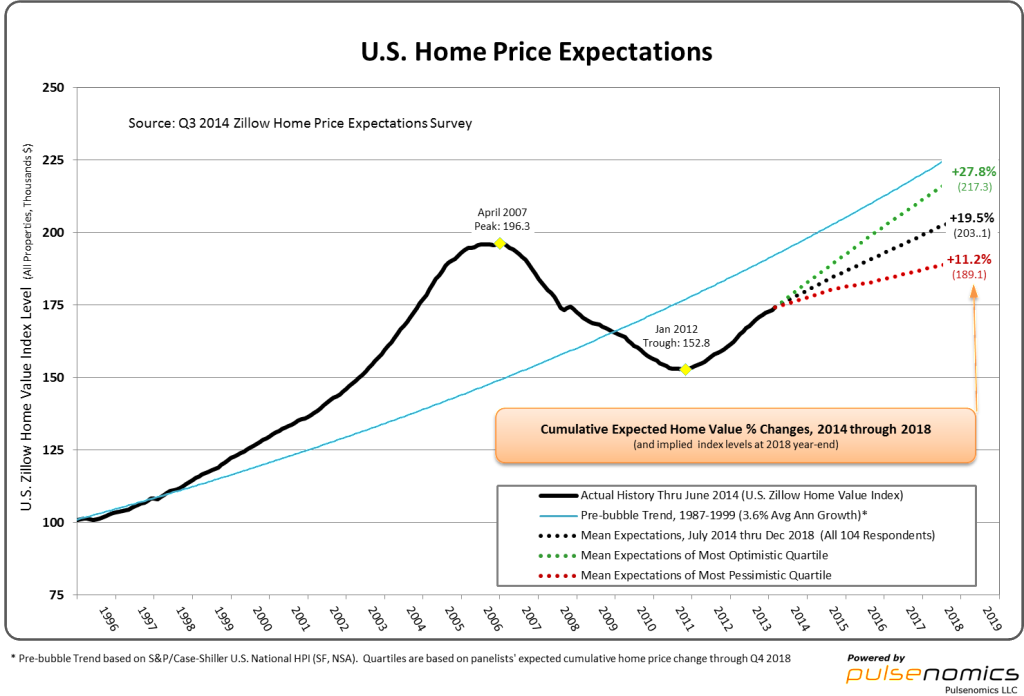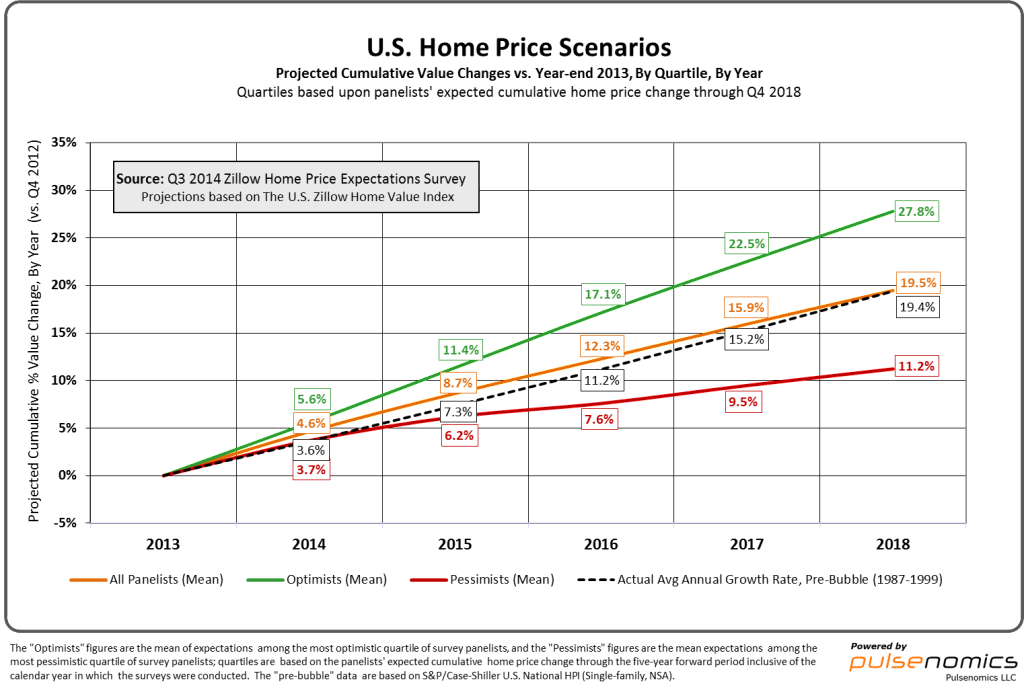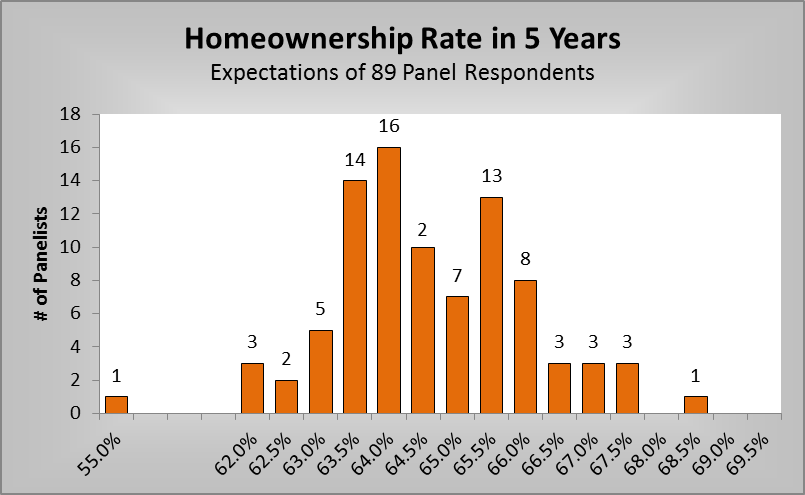Overview
- 104 housing experts and economists expect home prices to end 2014 up 4.6 percent year-over-year, on average, and almost 20 percent cumulatively through 2018.
- The typical age of first-time homebuyers is expected to rise in coming years as Millennials enter their prime home buying years. In 2013, the typical first-time homebuyer was 31.
- As the age of first-time homebuyers rises, experts expect the homeownership rate to drop.
Survey results
More than 100 housing experts said they expect U.S. home values to rise almost 20 percent cumulatively through 2018, and predicted that the age of the typical first-time homebuyer would rise over the next several years and the homeownership rate would fall.
The survey of 104 economists, real estate experts and investment and market strategists asked panelists to predict the path of the U.S. Zillow Home Value Index through 2018 and solicited opinions on future homeownership rates and demographic trends. The survey, released August 1, was sponsored by Zillow and is conducted quarterly by Pulsenomics LLC.
The panelists predict home prices to grow, on average, 19.5 percent through December 2018, unchanged from their prediction in the second quarter of 2014. The most optimistic quartile of panelists predict 27.8 percent cumulative appreciation, down from 30.8 percent in the previous quarter. The most pessimistic quartile predict 11.2 percent cumulative change in home values through the end of 2018, up from 9.4 percent in the second quarter survey.
On average, the panelists said they expect nationwide home value appreciation of 4.6 percent through the end of this year, to a Zillow Home Value Index of $177,895, 9.4 percent below the April 2007 peak value of $196,300. As of June 2014, the median U.S. home value was $174,200, down 11.3 percent from peak. Panelists said they expect annual home value appreciation to slow to 3.8 percent by the end of 2015, on average, and to 3.3 percent through 2016. During the pre-bubble years from 1987 to 1999, home values grew an average of 3.6 percent on an annual basis.
The most optimistic quartile of panelists predict a 5.6 percent annual increase in home values this year, on average, while the most pessimistic quartile predict an average increase of 3.7 percent. Panelists said they expected U.S. median home values to exceed their pre-recession peaks during the fourth quarter of 2017, and to top $200,000 in the second quarter of 2018. The most optimistic panelists predicted home values would rise roughly 11 percent above their 2007 peak by the end of 2018, on average, while the most pessimistic said they expected home values to remain about 4 percent below 2007 peak levels.
2014 Q3 Special Report: Homeownership Trends
Panelists were also asked for their opinions on the future of homeownership, revisiting a topic from the June 2012 Zillow Home Price Expectations Survey. At that time, the majority of panelists expressed the view that the national homeownership rate could dip below the then-current rate 65.4 percent in the next five years. In fact, the homeownership rate fell to 65 percent in the first quarter of 2013, and has continued to fall. As of the first quarter of 2014 – the most recent data available at the time the third-quarter survey was fielded – the national homeownership rate was 64.8 percent. The previous survey also found that one in five panelists believed that the future homeownership rate will be at or below 63 percent, testing or breaking the 62.9 percent rate established in 1965, the lowest on record.
Comparing the previous survey to the current survey, we find the panelists believe that the homeownership rate will continue to decline, but not as steeply. Fifty seven percent of panelists with an opinion (51/89) stated that they believe the homeownership rate five years from now will be below 64.8 percent. Four panelists predicted a rate below 62.9 percent, the lowest homeownership rate on record (1965 Q1). No panelists predicted home ownership to break its record high of 69.2 percent in Q2 2004.
Additionally, panelists were asked if they thought the age of first-time buyers would increase as the millennial generation reaches their prime home buying years. In 2013, according to the National Association of Realtors, the typical first-time homebuyer was 31 years old.
The vast majority of the panelists with an opinion (57/93) said they believe the median age of first-time homebuyers will “increase marginally, to 32 or 33.” Another 22 panelists said that they believe the median age of first-time buyers will “increase significantly, to 34 or older.” Demand for real estate later in life could mean stronger demand for rentals for the next few years, with existing home sales slowing until Millennials are ready to buy.
The last question in the survey touched on the effect mortgage rate changes will have on the volume of home sales. The majority of panelists said they believe that mortgage rate changes will have a negative effect on home sales, with 51 percent of panelists having an opinion stating that changes will have “a somewhat more negative impact on homes sales.” Eleven percent of panelists with an opinion thought that changes would have “a more significant negative impact on homes sales.” No panelists thought that mortgage rate changes would have a more significant positive impact on home sales.




